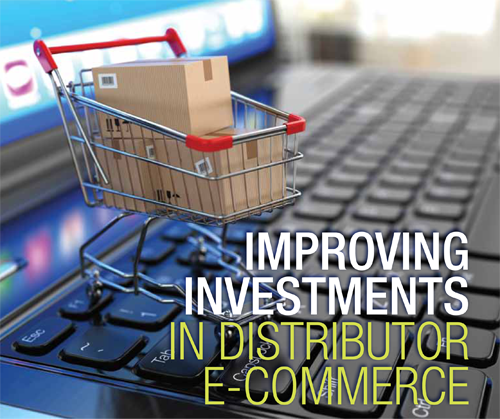Improving investments in distributor e-commerce

Where digital spending goes wrong and how to improve the return
by Scott Benfield
E-commerce has been a part of the durable goods distribution sector since the late 1990s. For all intents and purposes, the initial investments were for basic functionality in the ability to transact an order on the distributor’s site, search for availability and financial information and find basic product information. Our tracking of the technology, however, finds that today’s capabilities and customers’ demands are 180 degrees opposite those of a few short years ago. Those working from knowledge gleaned in the early years of the digitization of the industry should consider that most of the early know-how has little to do with what leaders in the sector are offering today.
Leading wholesalers began to invest heavily in e-commerce shortly after the recovery from the Great Recession. This was evidenced by the announcement two years ago of Grainger’s investment in its digital efforts with 300 positions in Chicago and the initial launch of AmazonSupply. These firms followed a contrarian strategy, investing in digital capabilities to capture a greater market share as the economy picked up to normal growth rates. Their efforts, for the most part, have succeeded. Our research “E-Commerce: Current Practice and Future Predictions in the B2B Wholesale Sector” finds that, for the $130 billion MRO sector, 20 percent of the firms are responsible for 80 percent of the e-commerce sales, which are approximately 11 percent of total sales. Growth in e-commerce purchases is less predictable. But the dynamics of the Millennial generation, which is 20 percent to 25 percent more likely to purchase online than preceding generations, will drive the online migration at a rate faster than sector growth. For those who don’t have current functionality, sales loss is all but assured.
Our work with distributors, most with less than $1 billion in sales, finds that they are woefully behind in e-commerce, relying on outdated technology and simple function systems common in the early days of digitization. For the most part, these firms have not rationalized resources to move from a traditional wholesale platform to one that recognizes the digital age. Following are common problems for distributors and where they need to invest to staunch the loss in digital sales.
Common Investment Mistakes in E-Commerce
1) The e-commerce strategy has no marketing strategy.
Our investigation of numerous wholesaler e-commerce efforts finds that they are devoid of a solid marketing strategy. Segments aren’t identified, products and product groups common to an application are not considered, and pricing is simply rolled over from existing pricing in the ERP system. Different segments have different e-commerce needs and are sensitive to different product groups. Without understanding these differences, wholesalers too often design a “vanilla” effort that misses the discrete needs of the segment. Too, pricing is often not researched and we find few wholesalers that engage statistical pricing services that compare online prices of competitors.
2) Me too, they don’t know what they don’t know either, and what about the customer?
Far too many wholesalers benchmark their e-commerce efforts with non-competitors in the same sector. If two firms, both with less than 5 percent of their sales in e-commerce, benchmark their efforts, they will likely come away assured that their progress is up to par. The problem is that 74 percent of wholesale firms sell 5 percent or less of their products online. Benchmarking one’s efforts at the local association meeting(s) has a high probability of putting two underperforming parties together to compare notes.
Wholesalers should also invest in current market research on the e-commerce effort. Assuming customers want more of what they’ve gotten in the past will lead to less e-commerce sales over time. Again, some wholesalers are dominant in e-commerce, transacting 50 percent or more of their sales online. Wholesalers should research their customers with both qualitative and quantitative instruments. They should strive to find which competitors lead in e-commerce and why. This will establish market validity for the digital investment.
3) We hired an e-commerce manager with great digital experience and support them with Millennials.
Too often we find where the corner office naively hires a manager steeped in e-commerce and surrounds them with Millennials to drive the e-commerce effort. This almost always fails. Why? Adopting a successful digital strategy takes much more than knowledge of the technology. It also takes a deep understanding of the industry commonly found in the existing sales and marketing pool, a good understanding of marketing process, and support from operations. In short, a winning digital strategy is a cross-functional effort. Firms that succeed in e-commerce almost always have a cross-functional effort, at least initially. The effort has a strong leader with valid experience in leading a complex project that respects the input of all functions. Hoping that the latest techie surrounded by techies can craft a long-lasting e-commerce effort is a Pollyanna.
4) We don’t need to involve the sales force in our e-commerce efforts.
The sales force is instrumental in helping existing customers migrate their purchases online. The customer must trust the e-commerce effort and the account seller must be able to steer the customer to online purchases by using the existing relationship. Of course, it helps if the e-commerce offering has the bugs worked out and the seller can give a positive assessment to the customer. Not including the seller in migrating purchases online, however, is a big mistake and don’t expect the B2B relationship, where trust is essential to commerce, to make the transition without seller involvement.
5) We can incrementally develop our existing technology and increase online sales.
New technologies that are essential in e-commerce, for B2B distributors, includes Product Information Management (PIM) and procurement punch-out. Both technologies began their genesis a decade or more ago but have been, largely, perfected as leaders in online sales drive functionality with their software vendors. PIM technology is essential to maintaining product content and updating it throughout the points in the supply chain.
Quality, searchable, reliable content is picked by wholesalers’ customers as the most important single feature of any e-commerce effort by a factor of 2:1. Our white paper called “Big Data or Not?” explains how in large SKU (over 100,000 units) digital offerings, almost all of the leading wholesalers had PIM technology in place.
Procurement punch-out allows the customer to place an order on the distributor’s site and “punch-out” the order into their system. It eliminates double order-entry while increasing order quality. Punch-out technology is offered in “suites” which allow the wholesaler to link their e-commerce module to a variety of ERP programs.
Without a PIM system and procurement punch-out, the ability to provide reliable content and order quality is greatly diminished. This functionality is expected by the customer and available today. An e-commerce effort without these technologies is simply obsolete.
Sales Loss is Now
With the economy on an upswing, many wholesalers don’t see the immediate need for
e-commerce investment. Plus, the online participation rate at 11 percent of sales and the fragmented nature of distributed markets makes any significant share loss unlikely. Our work and research in the sector, however, finds that a few firms are making big gains and are poised to take sales from their brethren with first-generation systems. The sales loss, for many wholesalers, has begun and will increase unless substantial investment in people, software and management time occurs.
Much of the investment is in time from executives to learn about the technology and guide the firm accordingly. Funding of necessary efforts will come from undifferentiated sales efforts and too many brick and mortar locations. While this is an unpopular answer,
it is largely what the leaders in e-commerce have done to drive their success. Solid marketing, customer research and cross-functional teams can be engaged today to build a modern platform. PIM and procurement punch-out software providers are vetted and can be amended to most modern e-commerce efforts.
Those who wait and see have, in our estimate, waited too long and should quickly reconsider their digital investment.
 Scott Benfield is a consultant for B2B channels, author of six books and numerous research studies on distribution channels. He was recently quoted in Forbes as a subject matter expert on AmazonSupply and e-commerce efforts in the wholesale sector. His firm is located in Chicago. Reach him at scott@benfieldconsulting.com or (630) 428-9311.
Scott Benfield is a consultant for B2B channels, author of six books and numerous research studies on distribution channels. He was recently quoted in Forbes as a subject matter expert on AmazonSupply and e-commerce efforts in the wholesale sector. His firm is located in Chicago. Reach him at scott@benfieldconsulting.com or (630) 428-9311.
This article originally appeared in the March/April 2015 issue of Industrial Supplymagazine. Copyright 2015, Direct Business Media.











